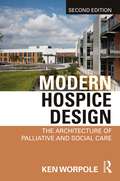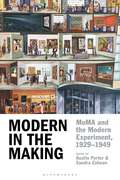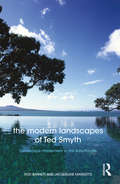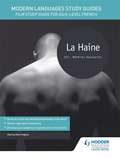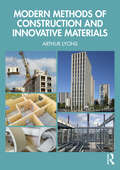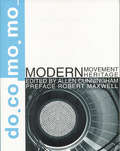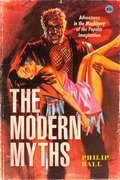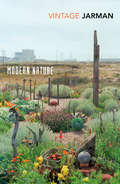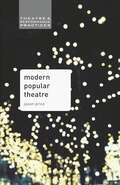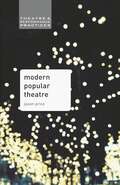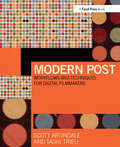- Table View
- List View
Modern Hospice Design: The Architecture of Palliative and Social Care
by Ken WorpoleThe new edition of this acclaimed book comprehensively updates its timely advocacy of the need for good quality palliative care, today more necessary than ever. Rooted in the social history of the care of the elderly and terminally ill, Modern Hospice Design: The Architecture of Palliative and Social Care takes cognisance of the new conditions of social care in the 21st century, principally in the UK, Europe and North America. It does so with regard to the development of new building types, but also in response to new philosophies of palliative care and the status of the elderly and the dying. Benefitting from a clearer methodological approach and conceptual framework, the expanded book allows a broad section of readers to navigate the text more easily. At its core is a public discussion of a philosophy of design for providing care for the elderly and the vulnerable, taking the importance of architectural aesthetics, the use of quality materials, the porousness of design to the wider world, and the integration of indoor and outdoor spaces as part of the overall care environment. In doing so it advocates care settings that, in the words of Maggie Jencks whose life and ideas inspired the Maggie’s Centres, ‘rise to the occasion’. Including new chapters and new in-depth case studies, complete will full colour illustrations, this book is for architects and interior designers and their students, healthcare professionals, social care providers, estate and facility managers, hospital administrators and Healthcare Trust Boards.
Modern in the Making: MoMA and the Modern Experiment, 1929–1949
by Austin Porter and Sandra ZalmanToday the Museum of Modern Art is widely recognized for establishing the canon of modern art; yet in its early years, the museum considered modern art part of a still unfolding experiment in contemporary visual production. By bracketing MoMA's early history from its later reputation, this book explores the ways the Museum acted as a laboratory to set an ambitious agenda for the exhibition of a multidisciplinary idea of modern art. Between its founding in 1929 and its 20th anniversary in 1949, MoMA created the first museum departments of architecture and design, film, and photography in the country, marshaled modern art as a political tool, and brought consumer culture into a versatile yet institutional context. Encompassing 14 essays that investigate the diversity of modern art, this volume demonstrates how MoMA's programming shaped a version of modern art that was not elitist but fundamentally intertwined with all levels of cultural production.
Modern in the Making: MoMA and the Modern Experiment, 1929–1949
Today the Museum of Modern Art is widely recognized for establishing the canon of modern art; yet in its early years, the museum considered modern art part of a still unfolding experiment in contemporary visual production. By bracketing MoMA's early history from its later reputation, this book explores the ways the Museum acted as a laboratory to set an ambitious agenda for the exhibition of a multidisciplinary idea of modern art. Between its founding in 1929 and its 20th anniversary in 1949, MoMA created the first museum departments of architecture and design, film, and photography in the country, marshaled modern art as a political tool, and brought consumer culture into a versatile yet institutional context. Encompassing 14 essays that investigate the diversity of modern art, this volume demonstrates how MoMA's programming shaped a version of modern art that was not elitist but fundamentally intertwined with all levels of cultural production.
Modern Islamic Authority and Social Change, Volume 2: Evolving Debates in the West
by Masooda BanoExplores the dynamic relationships between language, politics and society in the Middle East
Modern Islamic Authority and Social Change, Volume 2: Evolving Debates in the West
by Masooda BanoThe first systematic reading of Gilles Deleuze's mature philosophy through the lens of creative practice.
Modern Jeweler’s Consumer Guide to Colored Gemstones
by David FedermanSince early 1989, a gem dealer I've known for years has been calling me every few weeks to brief me on mounting mayhem in Colombia's lucrative emerald market. The troubling gist of these calls is always this: There is a full-fledged turf war going on between that South American country's bustling drug and gem trades for control of its emerald ex port business. According to this dealer and several others, anywhere from two to four thousand emerald industry people, mostly miners and deal ers, have been murdered since 1980. No doubt the gem sector, itself never gun shy, has retaliated in full and in kind. After all, the two groups have banded together in an intermittent alliance against a common enemy-Communist guerillas-with results the CIA would envy. I mention this bloodshed because of something the gem dealer once said to me: "I bet you never think of what a gem has to go through to get to a jewelry store:' He's right. I tend to think of colored stones as things of beauty, not objects of gruesome power struggles between mining kingpins and drug lords. Can you blame me, or anyone with insider knowledge, if a gem sheds any connection with its past once sculpted by a cutter into the glittering mar vel we see in a jeweler's showcase? Like Odysseus listening to the sirens' song, we become victims of an aesthetics-induced amnesia.
Modern Knitted Shawls and Wraps: 35 Warm And Stylish Designs To Knit, From Lacy Shawls To Chunky Afghans
by Laura Strutt35 beautiful knitting designs, ranging from a simple wrap in chunky yarn for beginners to a lightweight lace evening shawl for experienced knitters. There’s simply nothing more versatile than knitted shawls. They can be lacy or chunky, bright or neutral, cabled or just plain garter stitch, but they are always stylish, useful, and perfect for when you need a little extra warmth. Laura Strutt has designed 35 beautiful shawls and wraps, with something for everyone, from novice knitters to experts. Divided into Bright and Beautiful, Warm and Rich, and Neutral and Natural shades, the patterns use a complete rainbow of colours, including variegated yarns. The stitch patterns are just as diverse, with textured triangles, beaded lace stitches, and overlapping 'waves'. Start with a beautifully warm garter stitch wrap in a cool glacier blue – quick to knit even for a beginner – or a rainbow-striped triangular shawl. Then try a fashionable ombré-shaded shawl with an eyelet pattern, or a grey and white monochrome shawl with a bright contrast edging. For more experienced knitters, there are larger projects such as the brioche-stitch shawl, or the feather and fan stitch wrap in a variegated silk-based yarn. Whether you are knitting a cover-up for yourself, or a gift for a friend or family member, you will be spoilt for choice with these beautiful designs.
Modern Landscape Quilts: 14 quilt projects inspired by the great outdoors
by Donna McleodSew bold, modern landscape quilts inspired by wide open spaces with this collection of patterns for every quilter.Modern Landscape Quilts takes you on a journey with 14 original scenic projects inspired by the great outdoors. From the mountains to the beach, each easy-to-piece pictorial landscape design features a mini companion project for an even faster make.Illustrated step-by-step instructions and skill-building patchwork piecing methods, along with a detailed guide on how to construct a quilt from start to finish, make it a perfect all-in-one reference book for confident beginners and beyond.This book features:- Seven minimalist landscape themes with two designs each for a total of 14 quilt projects.- Clear and concise instructions to piece, sew and trim fundamental quilt blocks.- Dedicated chapters explaining how to quilt by machine or by hand.- Tips for efficient sewing as well as simple tricks to avoid common patchwork piecing issues.- Easy-to-follow instructions to create a wall hanging or pillow cover.The opening section includes a quick and comprehensive guide on understanding fabrics, choosing colors, and preparing fabrics for accurate cutting. Plus, bonus tips are provided to adapt some of the quilt patterns into other usable works of art. Machine quilting, along with in-depth tutorials on hand quilting and binding, allow makers to choose their destination on how to complete the projects in this book.Quilt designer and author, Donna McLeod, provides a versatile selection of time-conscious projects inspired by the diverse landscapes of California. Travel from the river to the woodlands in comfort at the flip of a page. Lots of the photography was done in the locations that inspired some of the designs in the book, inviting you to take photographs of your own Modern Landscape Quilts in the wild.
The Modern Landscapes of Ted Smyth: Landscape Modernism in the Asia-Pacific
by Jacqueline Margetts Rod BarnettThe modern period in landscape architecture is enjoying the fascinated appreciation of scholars and historians in Europe and the Americas, and new themes, new subjects and new appraisals are appearing. This book contributes to the conversation by focusing on the work of a singular designer who spent his entire career in a province of the North Island of New Zealand. Ted Smyth practiced an assured landscape modernism without ever seeing the designs of his forebears or his contemporaries working in the UK, Europe and the United States. Designing in isolation from the mainstream of modernism, and a little after its high tide, Smyth produced a series of gardens that provoke a revaluation of the diffusionist model of influence. The book explains and describes the evolution of Smyth’s design vocabulary and relates it to the development of tropical landscape modernism in other Asia-Pacific sites. It shows how a culture of garden modernism can be generated from within a particular locale, and highlights Smyth’s engagement with Māori design traditions in search of a specific expression of the high modern essentialism of place.
The Modern Landscapes of Ted Smyth: Landscape Modernism in the Asia-Pacific
by Jacqueline Margetts Rod BarnettThe modern period in landscape architecture is enjoying the fascinated appreciation of scholars and historians in Europe and the Americas, and new themes, new subjects and new appraisals are appearing. This book contributes to the conversation by focusing on the work of a singular designer who spent his entire career in a province of the North Island of New Zealand. Ted Smyth practiced an assured landscape modernism without ever seeing the designs of his forebears or his contemporaries working in the UK, Europe and the United States. Designing in isolation from the mainstream of modernism, and a little after its high tide, Smyth produced a series of gardens that provoke a revaluation of the diffusionist model of influence. The book explains and describes the evolution of Smyth’s design vocabulary and relates it to the development of tropical landscape modernism in other Asia-Pacific sites. It shows how a culture of garden modernism can be generated from within a particular locale, and highlights Smyth’s engagement with Māori design traditions in search of a specific expression of the high modern essentialism of place.
Modern Languages Study Guides: Film Study Guide for AS/A-level French (PDF)
by Karine HarringtonExam Board: AQA, Edexcel, OCR & WJEC Level: AS/A-level. Subject: Modern Languages. First Teaching: September 2016. First Exam: June 2017. Film analysis made easy. Build your students' confidence in their language abilities and help them develop the skills needed to critique their chosen work: putting it into context, understanding the themes and director's technique, as well as specialist terminology. Breaking down each scene, character and theme in La Haine (Hate), this accessible guide will enable your students to understand the historical and social context of the film and give them the critical and language skills needed to write a successful essay.
Modern Metaheuristics in Image Processing
by Diego Oliva Noe Ortega-Sánchez Salvador Hinojosa Marco Pérez-CisnerosThe use of metaheuristic algorithms (MA) has been increasing in recent years, and the image processing field is not the exempted of their application. In the last two years a big amount of MA has been introduced as alternatives for solving complex optimization problems. This book collects the most prominent MA of the 2019 and 2020 and verifies its use in image processing tasks. In addition, literature review of both MA and digital image processing is presented as part of the introductory information. Each algorithm is detailed explained with special focus in the tuning parameters and the proper implementation for the image processing tasks. Besides several examples permits to the reader explore and confirm the use of this kind of intelligent methods. Since image processing is widely used in different domains, this book considers different kinds of datasets that includes, magnetic resonance images, thermal images, agriculture images, among others. The reader then can have some ideas of implementation that complement the theory exposed of each optimization mechanism. Regarding the image processing problems this book consider the segmentation by using different metrics based on entropies or variances. In the same way, the identification of different shapes and the detection of objects are also covered in the corresponding chapters. Each chapter is complemented with a wide range of experiments and statistical analysis that permits the reader to judge about the performance of the MA. Finally, there is included a section that includes some discussion and conclusions. This section also provides some open questions and research opportunities for the audience.
Modern Metaheuristics in Image Processing
by Diego Oliva Noe Ortega-Sánchez Salvador Hinojosa Marco Pérez-CisnerosThe use of metaheuristic algorithms (MA) has been increasing in recent years, and the image processing field is not the exempted of their application. In the last two years a big amount of MA has been introduced as alternatives for solving complex optimization problems. This book collects the most prominent MA of the 2019 and 2020 and verifies its use in image processing tasks. In addition, literature review of both MA and digital image processing is presented as part of the introductory information. Each algorithm is detailed explained with special focus in the tuning parameters and the proper implementation for the image processing tasks. Besides several examples permits to the reader explore and confirm the use of this kind of intelligent methods. Since image processing is widely used in different domains, this book considers different kinds of datasets that includes, magnetic resonance images, thermal images, agriculture images, among others. The reader then can have some ideas of implementation that complement the theory exposed of each optimization mechanism. Regarding the image processing problems this book consider the segmentation by using different metrics based on entropies or variances. In the same way, the identification of different shapes and the detection of objects are also covered in the corresponding chapters. Each chapter is complemented with a wide range of experiments and statistical analysis that permits the reader to judge about the performance of the MA. Finally, there is included a section that includes some discussion and conclusions. This section also provides some open questions and research opportunities for the audience.
Modern Methods of Construction and Innovative Materials
by Arthur LyonsThis new textbook has two main themes. The first is Modern Methods of Construction (MMC) which is the off-site manufacture of a wide spectrum of products, ranging from whole buildings to be transported onto site, down to smaller units or components for site integration. The second theme describes the innovation and progress towards carbon zero by the major generators of CO2 in the construction industry – namely cement, steel and masonry.The first section of the book describes and illustrates with photographs, the major forms of Modern Methods of Construction. These include fully completed 3D units, panelised systems, pods, sub-assemblies and on-site MMC. The section on Innovative Materials then describes a wide range of construction products which are entering into the built environment sector. Some new entrants are variants on well-established construction materials such as steel and concrete. Materials such as these will remain major construction materials for the foreseeable future, but their composition and manufacturing processes will inevitably have to change. Timber also will remain a major construction material, but sustainable sourcing is key and its utilisation as cross-lamination timber (CLT) or as modified timber is rapidly developing. As a result, students and practitioners must familiarise themselves with these materials, their composition, and various uses.The book goes on to describe variants of other traditional building products, such as glass, plastic and insulation, which are undergoing major developments leading towards enhanced environmental sustainability, as well as many emergent materials, some of which are likely to be significant in future. Modern Methods of Construction and Innovative Materials is the only book combining these important elements of the future of the industry in an easy-to-read guide for students and new practitioners. It is essential reading for anyone studying and working in the built environment, be they architects, construction managers, surveyors or engineers.
Modern Methods of Construction and Innovative Materials
by Arthur LyonsThis new textbook has two main themes. The first is Modern Methods of Construction (MMC) which is the off-site manufacture of a wide spectrum of products, ranging from whole buildings to be transported onto site, down to smaller units or components for site integration. The second theme describes the innovation and progress towards carbon zero by the major generators of CO2 in the construction industry – namely cement, steel and masonry.The first section of the book describes and illustrates with photographs, the major forms of Modern Methods of Construction. These include fully completed 3D units, panelised systems, pods, sub-assemblies and on-site MMC. The section on Innovative Materials then describes a wide range of construction products which are entering into the built environment sector. Some new entrants are variants on well-established construction materials such as steel and concrete. Materials such as these will remain major construction materials for the foreseeable future, but their composition and manufacturing processes will inevitably have to change. Timber also will remain a major construction material, but sustainable sourcing is key and its utilisation as cross-lamination timber (CLT) or as modified timber is rapidly developing. As a result, students and practitioners must familiarise themselves with these materials, their composition, and various uses.The book goes on to describe variants of other traditional building products, such as glass, plastic and insulation, which are undergoing major developments leading towards enhanced environmental sustainability, as well as many emergent materials, some of which are likely to be significant in future. Modern Methods of Construction and Innovative Materials is the only book combining these important elements of the future of the industry in an easy-to-read guide for students and new practitioners. It is essential reading for anyone studying and working in the built environment, be they architects, construction managers, surveyors or engineers.
Modern Movement Heritage
by Allen CunninghamThis collection of essays serves as an introduction to modern architectural heritage and the specific problems related to the conservation of modern structures. It covers policy, planning and construction. A selection of case studies elaborates on these issues and illustrates how problems have been addressed. This volume celebrates the first 5 years of DoCoMoMo's role and influence in this important area of building conservation.
Modern Movement Heritage
by Allen CunninghamThis collection of essays serves as an introduction to modern architectural heritage and the specific problems related to the conservation of modern structures. It covers policy, planning and construction. A selection of case studies elaborates on these issues and illustrates how problems have been addressed. This volume celebrates the first 5 years of DoCoMoMo's role and influence in this important area of building conservation.
The Modern Myths: Adventures in the Machinery of the Popular Imagination
by Philip Ball"Impressive. . . . Rich in cultural history and imagination. . . . To Ball, mythic writing is where the conditions of irrationality, superstition, and enchantment persist: forms of wonder that depend on the disconnect between what we know for sure and what we simply believe.”—New York Times Book Review Myths are usually seen as stories from the depths of time—fun and fantastical, but no longer believed by anyone. Yet, as Philip Ball shows, we are still writing them—and still living them—today. From Robinson Crusoe and Frankenstein to Batman, many stories written in the past few centuries are commonly, perhaps glibly, called “modern myths.” But Ball argues that we should take that idea seriously. Our stories of Dracula, Dr. Jekyll and Mr. Hyde, and Sherlock Holmes are doing the kind of cultural work that the ancient myths once did. Through the medium of narratives that all of us know in their basic outline and which have no clear moral or resolution, these modern myths explore some of our deepest fears, dreams, and anxieties. We keep returning to these tales, reinventing them endlessly for new uses. But what are they really about, and why do we need them? What myths are still taking shape today? And what makes a story become a modern myth? In The Modern Myths, Ball takes us on a wide-ranging tour of our collective imagination, asking what some of its most popular stories reveal about the nature of being human in the modern age.
Modern Nature: The Journals of Derek Jarman (The\journals Of Derek Jarman Ser. #1)
by Derek JarmanA divine, meditative and inspiring diary of Derek Jarman's famous garden at Dungeness.'An essential – urgent – book for the 21st Century' Hans Ulrich ObristWITH AN INTRODUCTION BY OLIVIA LAINGIn 1986 Derek Jarman discovered he was HIV positive and decided to make a garden at his cottage on the barren coast of Dungeness. Facing an uncertain future, he nevertheless found solace in nature, growing all manner of plants. While some perished beneath wind and sea-spray others flourished, creating brilliant, unexpected beauty in the wilderness. Modern Nature is both a diary of the garden and a meditation by Jarman on his own life: his childhood, his time as a young gay man in the 1960s, his renowned career as an artist, writer and film-maker. It is at once a lament for a lost generation, an unabashed celebration of gay sexuality, and a devotion to all that is living.
The Modern Period Room: The Construction of the Exhibited Interior 1870–1950
by Penny Sparke Brenda Martin Trevor KeebleWith contributors drawn from a broad range of disciplines, The Modern Period Room brings together a carefully selected collection of essays to consider the interiors of the modern era and their more recent reconstructions from a variety of different viewpoints. Contributions from leading design historians, architects and curators of the history of the domestic interior in the UK engage with the issues and conventions surrounding the modern period room to expose the conflicting tensions that lie beneath the conceptual and physical strategy of the modern period room's representational technique. Exploring themes and examples by prestigious architects, such as Ernö Goldfinger, Truus Schroeder and Gerrit Rietveld, the authors reveal the specific coding of presented interior spaces. This illustrated new take on the historiography of twentieth century show interiors enables historians and theorists of architecture, design and social history to investigate the contexts in which this representational device has been used.
The Modern Period Room: The Construction of the Exhibited Interior 1870–1950
by Penny Sparke Brenda Martin Trevor KeebleWith contributors drawn from a broad range of disciplines, The Modern Period Room brings together a carefully selected collection of essays to consider the interiors of the modern era and their more recent reconstructions from a variety of different viewpoints. Contributions from leading design historians, architects and curators of the history of the domestic interior in the UK engage with the issues and conventions surrounding the modern period room to expose the conflicting tensions that lie beneath the conceptual and physical strategy of the modern period room's representational technique. Exploring themes and examples by prestigious architects, such as Ernö Goldfinger, Truus Schroeder and Gerrit Rietveld, the authors reveal the specific coding of presented interior spaces. This illustrated new take on the historiography of twentieth century show interiors enables historians and theorists of architecture, design and social history to investigate the contexts in which this representational device has been used.
Modern Playhouses: An Architectural History of Britain's New Theatres, 1945-1985
by Alistair FairModern Playhouses is the first detailed study of the major programme of theatre-building which took place in Britain between the 1950s and the 1980s. Drawing on a vast range of archival material - much of which had never previously been studied by historians - it sets architecture in a wide social and cultural context, presenting the history of post-war theatre buildings as a history of ideas relating not only to performance but also to culture, citizenship, and the modern city. During this period, more than sixty major new theatres were constructed in locations from Plymouth to Inverness, Aberystwyth to Ipswich. The most prominent example was the National Theatre in London, but the National was only the tip of the iceberg. Supported in many cases by public subsidies, these buildings represented a new kind of theatre, conceived as a public service. Theatre was ascribed a transformative role, serving as a form of 'productive' recreation at a time of increasing affluence and leisure. New theatres also contributed to debates about civic pride, urbanity, and community. Ultimately, theatre could be understood as a vehicle for the creation of modern citizens in a consciously modernizing Britain. Yet while recognizing, as contemporaries did, that the new theatres of the post war decades represented change, Modern Playhouses also asks how radically different these buildings really were, and what their 'mainstream' architecture reveals of the history of modern British architecture, and of post-war Britain.
Modern Popular Theatre (Theatre and Performance Practices)
by Jason PriceThis book offers a concise history of popular theatre since the early twentieth century. Using key popular culture theories and critical perspectives, Jason Price analyses popular theatres across different cultural and political contexts, drawing on a diverse range of international artists and theatre-makers who have worked with popular forms, including Vsevolod Meyerhold, Blue Blouse, Bertolt Brecht, Erwin Piscator, the San Francisco Mime Troupe, the Bread and Puppet Theatre and more. As well as defining what 'popular' means in relation to performance and the audiences who watch it, the book considers some of the political frameworks and causes that popular theatre has been placed in service of, such as socialism, the New Left and the gay rights movement. It also addresses the uses of cabaret, puppetry and circus outside their native popular contexts, examining the role they play in avant-garde and experimental theatre practices. In doing so, Price encourages readers to look beyond popular theatre as a simple form of entertainment and to consider its potential as a form of political activism, as a community-builder, and as a valuable tool for artistic experimentation.
Modern Popular Theatre (Theatre and Performance Practices)
by Jason PriceThis book offers a concise history of popular theatre since the early twentieth century. Using key popular culture theories and critical perspectives, Jason Price analyses popular theatres across different cultural and political contexts, drawing on a diverse range of international artists and theatre-makers who have worked with popular forms, including Vsevolod Meyerhold, Blue Blouse, Bertolt Brecht, Erwin Piscator, the San Francisco Mime Troupe, the Bread and Puppet Theatre and more.As well as defining what 'popular' means in relation to performance and the audiences who watch it, the book considers some of the political frameworks and causes that popular theatre has been placed in service of, such as socialism, the New Left and the gay rights movement. It also addresses the uses of cabaret, puppetry and circus outside their native popular contexts, examining the role they play in avant-garde and experimental theatre practices. In doing so, Price encourages readers to look beyond popular theatre as a simple form of entertainment and to consider its potential as a form of political activism, as a community-builder, and as a valuable tool for artistic experimentation.
Modern Post: Workflows and Techniques for Digital Filmmakers
by Scott Arundale Tashi TrieuWith the shift from film to digital, today’s filmmakers are empowered by an arsenal of powerful, creative options with which to tell their story. Modern Post examines and demystifies these tools and workflows and demonstrates how these decisions can empower your storytelling. Using non-technical language, authors Scott Arundale and Tashi Trieu guide you through everything you should consider before you start shooting. They begin with a look to past methodologies starting with traditional film techniques and how they impact current trends. Next they offer a look at the latest generation of digital camera and capture systems. The authors move on to cover: * Preproduction- what camera is best for telling your story and why, budgeting for post* Production- on-set data management, dailies, green screen, digital cinematography* Postproduction- RAW vs. compressed footage, editing, visual effects, color correction, sound and deliverables including DCP creation The book features cutting-edge discussion about the role of the digital imaging technician (DIT), how you can best use the Cloud, motion graphics, sound design, and much more. Case studies show you these solutions being applied in real-world situations, and the companion website features videos of techniques discussed in the book, as well as timely updates about technological changes in the landscape. www.focalpress.com/cw/arundale
